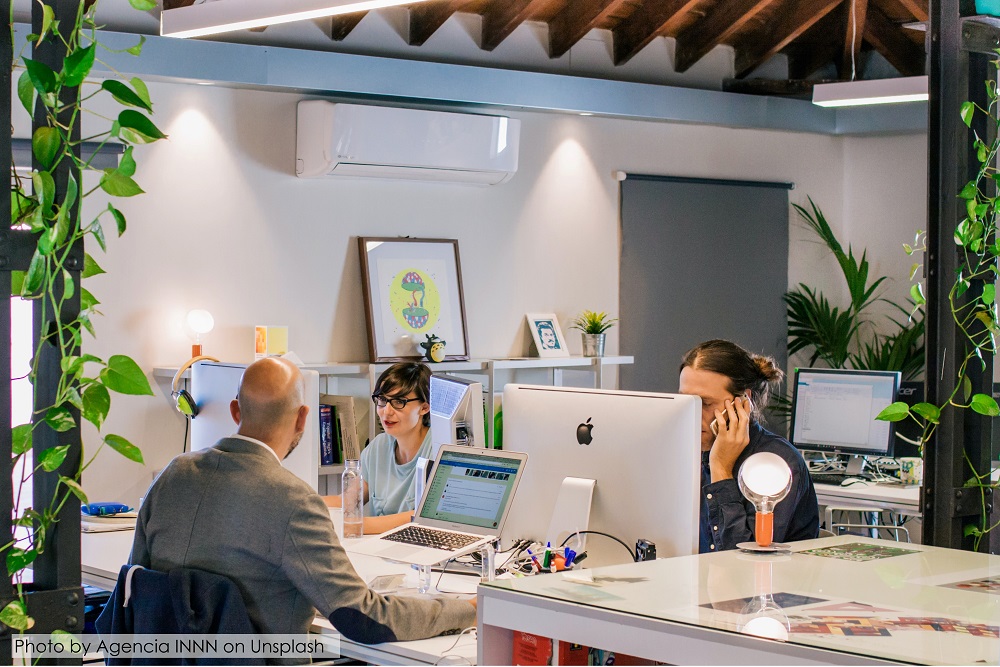
Most people in developed countries spend over 90% of their time indoors. Staff costs, including salaries and benefits, typically account for about 90% of business operating costs. Better staff health and wellbeing has a significant impact on increasing productivity, reducing costs and therefore enhancing business performance. So, what can we do to create green and healthy offices?
Staying ahead of the curve:
-
- People are interested in their own health. The consumer health market is expected to grow by 50% within 5 years.
- The office environment is vital in helping to attract and retain the best staff.
Tips for Green and Healthy Offices
Office Layout
-
- Design office environments to accommodate various staff needs.
- Have a layout that facilitates easy interaction and collaboration, with sufficient spaces for privacy and focus.
- Incorporate a diversity of space designs to suit different tasks and to mitigate noise levels.
- Provide social spaces for improved staff wellbeing.
Lighting
-
- Maximise and tap on natural daylight where possible. Studies indicate that adequate exposure to daylight can result in 46 minutes more sleep time per night.
- Enable lighting levels to be adjustable with changes in lighting levels to suit different tasks and use scenarios.
- Provide staff with local control of lighting levels at workspaces.
Indoor Air Quality
-
- Use materials with low levels of Volatile Organic Compounds (VOCs). VOCs are gases that can cause adverse health effects. They are emitted by building materials such as paints & adhesive, and office equipment such as copiers & printers.
- VOC concentration is generally higher indoors than outdoors (up to 10 times). Side effects of VOCs exposure include eye, nose and throat irritation, headache, nausea, damage to liver, kidney and central nervous system.
- The use of sensors enables VOCs, carbon dioxide and humidity levels to be monitored and actions to be taken accordingly.
- Optimise ventilation by providing fans where necessary and by arranging furniture without restricting airflow.
- Clean surfaces and use vacuum cleaners regularly to limit dust and dirt accumulation.
- Remove contaminated materials and address moisture sources promptly to prevent mould growth.
- Find out how our V-Buster Nano Composite Anti-Virus Circulation Lamp and KliqueCare NanoEcoShield™ can reduce VOCs and control mould growing.
Thermal Comfort
-
- Maintain room temperatures at a comfortable level, recommended to be in the range of 24 to 26 degree Celsius.
- Where possible, enable personal control of local climate. Studies have shown an increase in productivity by at least 3% when staff are able to control the temperature of their immediate surroundings.
Office Furniture
-
- Select office furniture that provides flexibility in adjustability of equipment as well as different working options e.g. standing desks.
- Consider the ergonomics of furniture, especially those where staff will spend a prolonged time in.
Greenery
-
- Views of nature have been shown to improve wellbeing and productivity. Green roofs, vertical gardens, indoor plants etc. can be incorporated into the building design or office environment.
- Indoor plants can help to improve the air quality by filtering harmful gases and pollutants.
- Choose and use plants that are hardy and require less maintenance.
- Use organic instead of chemical fertilisers and pesticides where needed.
Staff Wellbeing
-
- Consider flexible work arrangements and working hours to enhance staff wellbeing.
- Encourage regular rest of eyes from screen time. Besides improving eye health and reducing myopia, this has been shown to improve productivity by 7 to 12%.
Source: Singapore Green Building Council
